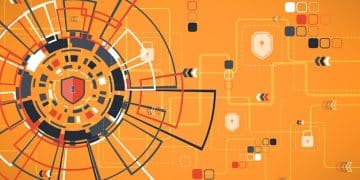US Cybersecurity Strategy: Protecting Against Foreign Threats

The US government employs a multifaceted cybersecurity strategy, integrating national and international efforts with public-private partnerships, to defend against evolving foreign cyber threats affecting critical infrastructure, economic stability, and national security.
In an increasingly digital world, the question of US cybersecurity strategy: how is the government protecting against foreign threats? resonates with profound urgency. Cyber attacks transcend physical borders, posing significant risks to national security, economic stability, and public confidence. Understanding the comprehensive approach taken by the US government to fortify its digital defenses is crucial for every citizen and stakeholder.
The Evolving Landscape of Cyber Threats
The digital frontier has become a primary battleground for state-sponsored actors, cybercriminals, and hacktivists. These entities relentlessly seek vulnerabilities in critical infrastructure, government systems, and private sector networks. The motivations behind these attacks are diverse, ranging from espionage and intellectual property theft to political disruption and economic sabotage.
The nature of cyber threats has evolved significantly over recent years. What once might have been considered isolated incidents have now coalesced into sophisticated, persistent campaigns. Adversaries leverage advanced techniques, including:
- Advanced Persistent Threats (APTs): Long-term, targeted attacks often backed by state actors, designed to maintain stealth access to a network.
- Supply Chain Attacks: Exploiting weaknesses in an organization’s software or hardware supply chain to gain unauthorized access.
- Ransomware Campaigns: Disrupting operations by encrypting data and demanding payment, often targeting critical services like healthcare and finance.
- Disinformation and Influence Operations: Using digital platforms to spread false narratives and manipulate public opinion, often with geopolitical aims.
Each type of threat requires a nuanced defense, compelling the US government to adopt a dynamic and adaptive cybersecurity strategy. The lines between cyber warfare, cyber espionage, and cybercrime continue to blur, making attribution and response increasingly complex. The interconnectedness of global digital systems means that a vulnerability in one sector can quickly cascade, affecting others across national and international boundaries. Therefore, the defense mechanisms must be holistic, resilient, and collaborative.
The sheer volume and sophistication of these threats necessitate constant innovation in defense. Attackers are often agile, adapting their tactics to bypass conventional security measures. This arms race in cyberspace demands a proactive stance from the US government, moving beyond mere reaction to preemptive defense and disruption. The objective is not just to repel attacks but to deter potential adversaries by demonstrating robust capabilities and a clear resolve to protect national interests.
Key Pillars of US Cybersecurity Policy
The US cybersecurity strategy stands on several foundational pillars, designed to provide a layered defense against foreign threats. These pillars reflect a comprehensive approach, recognizing that no single agency or tactic can secure the vast and complex digital ecosystem. This strategy is continually refined to address emerging threats and technological advancements.
One primary pillar is the emphasis on robust governmental frameworks and directives. Agencies like the Cybersecurity and Infrastructure Security Agency (CISA), the National Security Agency (NSA), and the Department of Defense (DoD) play critical roles in implementing and enforcing cybersecurity policies. These policies span various domains, from protecting federal networks to providing guidance for critical infrastructure operators.
Legislative and Regulatory Frameworks
Legislation forms the backbone of the US cybersecurity posture, providing the legal authority and funding necessary for defense operations. Recent legislative efforts have focused on enhancing information sharing, hardening federal networks, and establishing clear roles and responsibilities across government and industry. These laws aim to standardize security practices and ensure accountability.
- Cybersecurity Act of 2015: Enhanced information sharing between the government and private sector regarding cyber threats.
- National Defense Authorization Act (NDAA) Provisions: Frequently include significant cybersecurity mandates for the DoD and other agencies.
- Executive Orders: Presidential directives, such as those related to improving the nation’s cybersecurity, set immediate priorities and actions for federal agencies.
Beyond legislation, regulatory bodies consistently update standards and guidelines. For instance, the National Institute of Standards and Technology (NIST) Cybersecurity Framework provides a voluntary guide for organizations to manage and reduce cybersecurity risks. While voluntary for most private sector entities, it is widely adopted and often mandated for federal contractors.
Another critical aspect is the push for modernization of federal IT systems. Many legacy systems are inherently vulnerable due to outdated architecture and lack of patching. Significant investments are being made to upgrade these systems, implement zero-trust architectures, and transition to cloud-based solutions, which often offer enhanced security features.
The government also prioritizes workforce development. The demand for skilled cybersecurity professionals far outstrips supply, both within government and the private sector. Initiatives focus on training, recruitment, and retention programs to build a robust talent pipeline capable of tackling advanced cyber threats. This includes partnerships with academic institutions and specialized training programs for federal employees.
Interagency Cooperation and Collaboration
Effective cybersecurity against foreign threats requires seamless collaboration across numerous federal agencies, each bringing unique capabilities and intelligence. The US government recognizes that a fragmented approach would leave critical gaps in its defenses. Therefore, significant emphasis is placed on establishing clear communication channels and shared objectives among diverse entities.
The relationship between intelligence agencies and law enforcement is particularly crucial. Intelligence agencies, such as the NSA and the CIA, collect information on foreign adversaries’ cyber capabilities and intentions. This intelligence is then shared with agencies like the Federal Bureau of Investigation (FBI) and the Department of Justice (DOJ), which lead efforts in prosecuting cybercriminals and responding to active cyber incidents. The synergy between intelligence gathering and operational response is vital for timely and effective mitigation.
Key Collaborators and Their Roles
- Cybersecurity and Infrastructure Security Agency (CISA): Acts as the national risk advisor, working with private and public entities to understand and manage cyber and physical risks to critical infrastructure.
- National Security Agency (NSA): Focuses on signals intelligence (SIGINT) and information assurance (IA), safeguarding US national security systems and providing cybersecurity support to the DoD.
- Federal Bureau of Investigation (FBI): Investigates cybercrimes, including state-sponsored intrusions, and works to disrupt malicious cyber operations.
- Department of Defense (DoD) & US Cyber Command (USCYBERCOM): Responsible for defending military networks and conducting offensive cyber operations when authorized to deter and disrupt adversarial activities.
Beyond federal agencies, state and local governments are increasingly integrated into the national cybersecurity ecosystem. CISA, for instance, provides resources, training, and threat intelligence to enhance the cyber resilience of state and local entities, recognizing that these often control critical infrastructure components such as water systems, power grids, and election infrastructure. This decentralized yet coordinated defense strengthens the overall national posture against cyber threats.
Joint task forces and interagency working groups are common mechanisms for fostering this cooperation. These groups allow for real-time information exchange, coordinated response planning, and the development of shared best practices. The goal is to eliminate silos and ensure that all relevant parties have access to the latest threat intelligence and defensive strategies. This collaborative spirit extends to regular exercises and simulations that test the nation’s collective response capabilities, identifying weaknesses and refining protocols before real-world incidents occur.
Public-Private Partnerships and Information Sharing
The vast majority of critical infrastructure in the US is owned and operated by the private sector. This reality necessitates strong public-private partnerships as a cornerstone of the nation’s cybersecurity strategy. The government cannot effectively protect against foreign threats without the active participation and cooperation of private industry. These partnerships primarily revolve around robust information sharing mechanisms, enabling both sides to leverage collective insights.
Information sharing is bidirectional. The government shares classified and unclassified threat intelligence with companies, providing insights into emerging threats, attack methodologies, and indicators of compromise (IOCs). This allows private sector entities to proactively bolster their defenses and prepare for potential attacks. In return, private companies report cyber incidents and vulnerabilities to the government, providing crucial real-time data that aids in understanding the scope of threats and developing effective countermeasures. This symbiotic relationship enhances overall situational awareness.
Key Initiatives for Collaboration
- Information Sharing and Analysis Centers (ISACs): Industry-specific organizations that serve as central points for gathering, analyzing, and disseminating cyber threat and vulnerability information. Examples include the Electricity ISAC and the Financial Services ISAC.
- Cybersecurity Advisory Committee (CSAC): Established by CISA, this committee brings together private sector leaders to provide recommendations on improving cybersecurity and critical infrastructure protection.
- Joint Cyber Defense Collaborative (JCDC): An initiative led by CISA that unifies the defensive efforts of the US government, critical infrastructure, and the cybersecurity industry to achieve specific cybersecurity outcomes.
Beyond formal initiatives, informal networks and trusted relationships play a significant role. Regular dialogues, workshops, and joint training exercises help build trust and foster a shared sense of responsibility. This collaborative environment ensures that the latest threat intelligence and mitigation strategies are rapidly disseminated and acted upon across the nation’s digital infrastructure. It also allows for the development of shared technical standards and best practices that raise the baseline level of security for all participants.

Challenges certainly exist within these partnerships, including concerns over information privacy, liability issues, and the speed of information processing. However, significant progress has been made in addressing these concerns, fostering an environment where sensitive information can be shared securely and efficiently. The recognition that a strong defense requires a unified front has driven both government and industry to overcome these hurdles, culminating in a more resilient national cybersecurity posture.
International Cooperation and Diplomacy
Cyber threats are inherently global, transcending national borders and requiring a coordinated international response. No single nation, however powerful, can unilaterally defend against advanced state-sponsored cyber operations or widespread cybercriminal networks. Therefore, international cooperation and diplomacy are indispensable components of the US cybersecurity strategy: how is the government protecting against foreign threats?
The US actively engages with allies and partners through various multilateral forums and bilateral agreements to counter cyber threats. These engagements focus on several key areas:
Global Initiatives and Partnerships
- NATO: The US plays a leading role in NATO’s efforts to enhance cyber defense capabilities among member states, including joint exercises and intelligence sharing.
- Quad Leaders Dialogue: Cooperation with Australia, India, and Japan on cybersecurity, critical technology supply chains, and digital infrastructure resilience.
- G7 and G20: Discussions within these economic forums often include cybersecurity, aiming to establish international norms of responsible state behavior in cyberspace and combat cybercrime.
- Bilateral Agreements: Formal agreements with key allies like the UK, Canada, and European Union member states facilitate direct intelligence sharing, joint investigations, and coordinated responses to cyber incidents.
Beyond these formal structures, the US engages in cyber diplomacy to establish and promote international norms of behavior in cyberspace. This includes advocating against malicious state-sponsored cyber activities, condemning intellectual property theft, and promoting transparency and accountability. The goal is to build a consensus around what constitutes permissible and impermissible state action in the digital realm, thereby reducing the likelihood of conflict and fostering a more stable cyber environment.
Capacity building in partner nations is another critical aspect. The US provides assistance and training to allied countries to help them strengthen their cyber defenses, particularly in developing nations that may lack the resources and expertise. This not only enhances global cybersecurity but also reduces the risk of these nations being exploited as launching pads for attacks against the US or its allies. Investing in global cyber resilience benefits everyone.
International law enforcement cooperation is vital for prosecuting cybercriminals who often operate across borders. Agencies like the FBI and DOJ work closely with Interpol and Europol, as well as individual national law enforcement agencies, to track down, apprehend, and extradite cybercriminals. This collaborative effort sends a strong message that cybercrime will not go unpunished, regardless of where the perpetrators are located.
The ongoing challenge in international cooperation lies in differing national interests, legal frameworks, and varying levels of cybersecurity maturity. Despite these complexities, the US remains committed to multilateral engagement, recognizing that a unified global front is the most effective way to safeguard the digital commons from pervasive foreign threats. This diplomatic effort is a continuous process, adapting to the latest geopolitical shifts and technological advancements.
Future Outlook and Emerging Challenges
The landscape of cyber threats is dynamic, and the US cybersecurity strategy must continuously adapt to stay ahead of adversaries. Looking forward, several emerging technologies and geopolitical shifts present new challenges and opportunities for strengthening national defenses. The objective remains to build enduring cyber resilience across all sectors.
One of the most significant emerging challenges comes from advancements in artificial intelligence (AI) and quantum computing. AI can be leveraged by both defenders and attackers; while it can enhance threat detection and automate responses, it can also be used to create highly sophisticated malware, craft convincing phishing campaigns, and automate reconnaissance at an unprecedented scale. Quantum computing, while still in its nascent stages, poses a long-term threat to current encryption standards, potentially rendering much of today’s secure communication vulnerable.
Key Future Concerns
- AI-Powered Attacks: The rapid development of AI could lead to more autonomous, adaptive, and evasive cyber threats, requiring equally advanced AI-driven defenses.
- Quantum Computing: The eventual development of cryptographically relevant quantum computers could break many widely used public-key encryption algorithms, necessitating a transition to quantum-safe cryptography.
- Internet of Things (IoT) Security: The proliferation of interconnected devices, from smart homes to industrial control systems, vastly expands the attack surface, many with insufficient inherent security.
- Social Engineering at Scale: AI-driven deepfakes and advanced social engineering tactics will make it harder for individuals and organizations to discern legitimate communications from malicious ones.
The geopolitical climate also profoundly impacts the cybersecurity outlook. Increased tensions among global powers can escalate state-sponsored cyber warfare, targeting critical infrastructure, disrupting elections, or stealing sensitive data. Maintaining deterrence through robust defense and the credible threat of retaliation remains a core component of the strategy. This requires continuous investment in offensive and defensive cyber capabilities.

Another area of focus is the resilience of critical supply chains, particularly for essential technologies. Dependency on foreign-made hardware and software components introduces potential vulnerabilities that adversaries could exploit. Efforts are underway to diversify supply chains, encourage domestic manufacturing, and implement rigorous security vetting for components sourced from abroad. This ensures the integrity of the foundational technology upon which the nation’s digital infrastructure relies.
Finally, continuous workforce development and public education are crucial. As technology evolves, so too must the skills of cybersecurity professionals. Investing in training and education programs is paramount. Simultaneously, raising public awareness about common cyber threats and safe online practices empowers individuals to be the first line of defense, reducing their vulnerability to phishing, malware, and social engineering attacks. The future of US cybersecurity rests on a blend of technological advancement, strategic policy, and human expertise.
| Key Pillar | Brief Description |
|---|---|
| 🛡️ Policy & Legislation | Establishing robust legal frameworks and directives to guide national cybersecurity efforts and ensure compliance. |
| 🤝 Interagency Cooperation | Fostering seamless collaboration and intelligence sharing among federal agencies like CISA, NSA, and FBI. |
| 🔗 Public-Private Partnerships | Engaging private sector critical infrastructure operators for information sharing and joint defense initiatives. |
| 🌍 International Diplomacy | Collaborating with allies and international bodies to establish norms and combat cross-border cyber threats. |
Frequently Asked Questions
▼
CISA, or the Cybersecurity and Infrastructure Security Agency, serves as the national risk advisor for critical infrastructure. Its primary role involves working with both public and private sector entities to understand, manage, and reduce risks to cyber and physical infrastructure. CISA provides threat intelligence, resources, and guidance to enhance the resilience of essential services and systems nationwide.
▼
The US government addresses state-sponsored cyber espionage through a multi-pronged approach that includes intelligence gathering by agencies like the NSA, defensive measures to harden networks, and international diplomatic efforts to establish norms against such activities. It also involves law enforcement investigations by the FBI to identify and prosecute perpetrators, often in coordination with international partners, sending a strong deterrent message.
▼
Private companies play a critical role, as they own and operate most of the nation’s critical infrastructure. They are essential partners in cybersecurity through information sharing, reporting incidents, and implementing robust security measures. Public-private partnerships, like ISACs and the JCDC, facilitate the exchange of threat intelligence and best practices, significantly bolstering the collective defense against foreign threats.
▼
New technologies like AI and quantum computing present both opportunities and challenges. AI can enhance defensive capabilities through advanced threat detection and automated responses, but it also enables attackers to create more sophisticated and evasive threats. Quantum computing could eventually break current encryption methods, necessitating a proactive shift to quantum-safe cryptography to protect future communications and data.
▼
The US participates in numerous international efforts, including collaborations with NATO, the Quad Leaders Dialogue, and various UN working groups. These efforts aim to establish global norms for responsible state behavior in cyberspace, share threat intelligence, conduct joint cyber defense exercises, and provide capacity-building assistance to partner nations. This collective approach is crucial for addressing the inherently global nature of cyber threats effectively.
Conclusion
The US cybersecurity strategy: how is the government protecting against foreign threats? reveals a complex, continuously evolving, and deeply integrated effort. From strengthening domestic frameworks and fostering interagency cooperation to championing robust public-private partnerships and leading international diplomatic initiatives, the approach is multifaceted. The digital battlefield demands agility, foresight, and unwavering collaboration to safeguard national security, economic prosperity, and the trust placed in digital systems by its citizens. As cyber adversaries grow in sophistication, the commitment to adaptive defenses, technological innovation, and collective action will remain paramount in defending the nation’s digital frontier.





